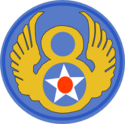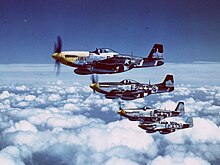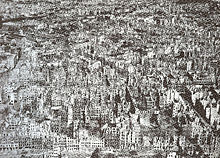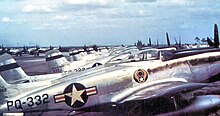Eighth Air Force
Its flexible, conventional and nuclear deterrence mission provides the capability to deploy forces and engage enemy threats from home station or forward positioned, anywhere, any time.This air power includes the heart of America's heavy bomber force, deploying the Rockwell B-1 Lancer, Northrop Grumman B-2 Spirit and the Boeing B-52 Stratofortress.Kegelman's aircraft lost altitude and even bounced off the ground, but he was able to bring the damaged bomber home and received the Distinguished Service Cross (DSC) from General Carl Spaatz on 11 July.Eighth Air Force carried out strategic daytime bombing operations in Western Europe from airfields in eastern England as part of the Combined Bomber Offensive.The Pointblank directive of June 1943 redirected the Allied strategic bombing effort against the German air force in order to reduce it to the point where it could not oppose the planned invasion of France in mid-1944.Also in June 1943, two groups of the Eight Air Force from England began training for the upcoming Operation Tidal Wave, a low-level raid on the Ploiești refineries in Romania."[citation needed] Spaatz and Doolittle's plan was to use the US Strategic Air Forces in a series of co-ordinated raids, code-named Operation 'Argument' (popularly known as 'Big Week' ) and supported by RAF night bombing, on the German aircraft industry at the earliest possible date.The B-24s hit the Gothaer Waggonfabrik (production of Messerschmitt Bf 110 heavy fighters), the Fw 190 Arado Flugzeugwerke plant at Tutow and Heinkel's "Heinkel-Nord" headquarters at Rostock, which produced He 111 bombers.The Luftwaffe, conversely, was undertaking the sixth major raid of the "Baby Blitz" the following night (20/21 February), with only some 165 German aircraft sortieing against British targets.On 24 February, with the weather clearing over central Germany, the Eighth Air Force sent over 800 bombers, hitting Schweinfurt and attacks on the Baltic coast, with a total of 11 B-17s being lost.On 6 March 1944, over 700 heavy bombers along with 800 escort fighters of the Eighth Air Force hit numerous targets within Berlin, dropping the first American bombs on the capital of the Third Reich.In a prelude to the invasion of France, Allied strategic bomber forces were switched from industry to the transport network to isolate Normandy from enemy reinforcement routes.Air attacks by American forces against railroad junctions, airfields, ports and bridges in northern France and along the English Channel coastline began in February 1944.Fighters from both Eighth and Ninth Air Forces made wide sweeps over the area, mounting strafing missions at airfields and rail networks.On 1 May, over 1,300 Eighth Air Force heavy bombers made an all-out attack on the enemy's rail network, striking at targets in France and Belgium.On D-Day, over 2,300 sorties were flown by Eighth Air Force heavy bombers in the Normandy and Cherbourg invasion areas, all aimed at neutralizing enemy coastal defenses and front-line troops.The North American P-51 Mustang[c] first entered squadron service in Europe with the British in early 1942; having much success with the RAF, although it found the Allison V-1710-engined aircraft's performance inadequate at higher altitudes.This strategy fatally disabled the twin-engined Zerstörergeschwader heavy fighter wings and their replacement, single-engined Sturmgruppen of heavily armed Fw 190As, clearing each force of bomber destroyers in their turn from Germany's skies throughout most of 1944.On 1 January, the entire German fighter force in the West, comprising combat aircraft from some eleven Jagdgeschwader day fighter wings, took off and attacked 27 Allied airfields in northern France, Belgium and the southern part of the Netherlands in an attempt by the Luftwaffe to cripple Allied air forces in the Low Countries of Europe.The Luftwaffe countered by installing flak alleys along the approach lines in order to protect the Me 262s from the ground and providing top cover with conventional fighters during takeoff and landing.Eighth Air Force flew its last full-scale mission of the European War on 25 April 1945 when its B-17s hit the Skoda armaments factory at Pilsen in Czechoslovakia, and B-24s bombed rail complexes in Bad Reichenhall and Freilassing, surrounding Hitler's mountain retreat at Berchtesgaden.However, it was believed that a strong strategic air arm equipped with B-29s would deter a possible aggressor from attacking the United States for fear of massive retaliation with nuclear weapons.From 1946 through 1949, what little money became available was used to buy new planes (Boeing B-50 Superfortress, Convair B-36 Peacemaker) for SAC, and as the newer aircraft became available, the older B-29s were sent to storage depots or sent to Air Force Reserve units for training missions.For its Korean War service, the 27th Fighter-Escort Wing received the Distinguished Unit Citation, covering the period of 26 January through 21 April 1951, for their actions in Korea.The 27th was relieved of its duties supporting U.N. forces in Korea and returned to Bergstrom AFB on 31 July 1951, but was redeployed to Misawa AB, Japan during 6 October 1952 – 13 February 1953 to provide air defense.At the same time, aerial refueling techniques were improved to the extent that Eighth Air Force bombers could still reach targets in Europe and Asia even if overseas bases were destroyed by an enemy attack.As a headquarters, the Eighth had another important role in victory over Iraqi forces – operating the logistics supply and air refueling bridge between the U.S. and gulf region.The "Allied Force" campaign also marked the Eighth's return to Europe and the participation of U.S. bombers in the North Atlantic Treaty Organization's (NATO) first combat operation.Altogether, the Eighth's bombers flew 325 sorties to drop over 7 million pounds of ordnance on a nation slightly smaller than the state of Colorado.For the Mighty Eighth, that change heralded an interesting future, one that bring further restructuring, different aircraft system purchases, and a new challenging mission to the NAF.






















The Mighty Eighth20th Bombardment WingUnited StatesUnited States Air ForceUnited States ArmyArmy Air ForcesNumbered Air Forceconventionalnuclearbomber forcesU.S. Strategic Commandair componentglobal strikeAir Force Global Strike CommandBarksdale Air Force BaseBossier Parish, LouisianaWorld War II – European-African-Middle Eastern TheaterWorld War II – Asiatic-Pacific TheaterAir Force Outstanding Unit Award with Combat "V" DeviceAir Force Outstanding Unit AwardRepublic of Vietnam Gallantry Cross with PalmMaj. Gen.Jason ArmagostBrig. Gen.James DoolittleIra C. EakerCarl "Tooey" SpaatzSamuel E. AndersonUnited States Strategic CommandNorthrop Grumman B-2 SpiritRockwell B-1 LancerBoeing B-52 StratofortressUnited States Army Air ForcesEast AngliaCombined Bomber OffensiveEuropean theater of World War IIarea of responsibilitystrategic bombingCold WarStrategic Air CommandWestover Air Force BaseKorean WarVietnam WarGulf WarFirst Persian Gulf WarAir National GuardAir Force Reserve2d Bomb Wing5th Bomb WingMinot Air Force Base307th Bomb Wing509th Bomb WingMissouri Air National Guard131st Bomb WingWhiteman AFB7th Bomb WingDyess AFB28th Bomb WingEllsworth AFBAir Force Reserve Command10th Air ForceUnited States Air Forces in EuropeLangley FieldSavannah Army Air BaseGeorgiaRAF Daws HillRAF Bomber CommandRAF High Wycombe97th Bombardment GroupRAF PolebrookRAF Grafton UnderwoodB-17 Flying FortressesEastern EuropeWorld War IIDouglas Boston (A-20 Havoc)15th Bombardment Squadron (Light)No. 226 Squadron RAFNetherlandsDe Kooy AirfieldDistinguished Service CrossCarl SpaatzBoeing B-17E Flying FortressesRouen-Sottevillemarshalling yardsFrank A. ArmstrongPaul TibbetsLittle BoyHiroshimaBoeing B-29 SuperfortressEnola GayBritish IslesairfieldsPointblank directiveOperation Tidal WavePloieștiAllied invasion of Sicily398th Air Expeditionary GroupNeumünsterNazi GermanyVictory in Europe DayYouTubeConsolidated B-24 LiberatorsUnited States Strategic Air ForcesNinth Air ForceJimmy DoolittleNathan F. TwiningLieutenant GeneralBig Weekbombed LeipzigNorth American P-51 MustangsSupermarine SpitfiresLeipzigJunkers Ju 88Messerschmitt Bf 109BernburgJunkersOscherslebenFocke Wulf Fw 190AGothaer WaggonfabrikMesserschmitt Bf 110Arado FlugzeugwerkeHeinkelRostockHe 111LuftwaffeBraunschweig